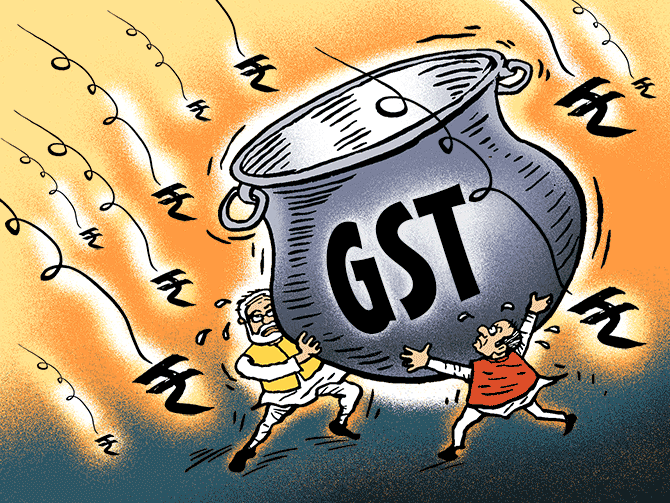 | « Back to article | Print this article |
'One way to deal with these is to address these quickly and have rapid reaction teams in New Delhi, the state capitals and wherever possible.'
Illustration: Dominic Xavier/Rediff.com

Infosys Co-founder N R Narayana Murthy believes the goods and services tax will simplify trade, boost the economy, and generate jobs.
While the GST Network might encounter a few teething problems, that was part of any large implementation, he tells Raghu Krishnan.
Do you think implementation of the GST would boost economic growth?
There are different estimates of the impact of the GST.
A National Council of Applied Economic Research report says GDP (gross domestic product) will have an additional 1 to 2 per cent growth.
I'm also told there is a US Fed Reserve report claiming the GST would boost India's growth by 4 per cent.
That would be fabulous.
There is absolutely no doubt the GST will boost GDP, as the new tax regime will remove hassles to trade.
This will help entrepreneurs and the whole country will benefit.
Do you think more people will enter the formal economy?
When you have a nation-wide tax, which is clear and easy to comply with, it is natural more people will move into the formal sector.
Besides generating more revenue for the government, it will also benefit workers in small units.
Once you enter the formal sector, you have to follow a lot of rules.
The GST will also help improve internal trade.
But commodities such as petroleum and alcohol are out of the ambit...
The first step was creating the GST framework.
Including petroleum products will now be easier.
The GST has taken a lot of time to get to this stage; we should give the government credit for it.
This was not an easy task, requiring the cooperation of various political parties. There are still a few issues.
The prime minister has shown extraordinary tenacity in making this happen; he could have easily postponed it by a year.
Some products -- petroleum, clothing, and footwear -- might become a bit dearer.
All of us will have to make a few adjustments.
I don't think any progress is possible without a little pain.
There are concerns over the technology infrastructure for the GST...
After 50 years in the technology sector, I have realised there's no system in the world that will be free of some glitches in the first six months.
There might be problems.
One way to deal with these is to address these quickly and have rapid reaction teams in New Delhi, the state capitals and wherever possible.
Ships are safest in the harbour. But they are not meant to be there.
They have to go into the high seas, face storms and reach the comfort of a desirable destination.
Let us not unnecessarily worry about possible problems.
People say there would be an inflationary trend because of the GST...
We are moving towards a value-added tax regime, rationalising multiple central and state taxes.
When this is applied across the nation, across all traders, big and small, some commodities will get expensive and some cheaper.
The beauty of the GST is that it helps the government collect huge amounts of data: Which product is selling for how much, what tax is being collected on it.
This huge data will help the government make a proper analysis of how the economy is moving.
We should be a little patient and allow the government a few years.
In your interaction with global investors and leaders, what is their perception of the GST?
I don't think India is very high on the radar screen of most nations.
I don't know how many of the senior management personnel are really concerned about the GST.
At least based on discussions, I have not felt this has become a big topic of conversations.
This initiative will reduce hassles for anybody who wants to operate in India.
They will realise this system is comparable to the developed countries.
I don't think we should be worried about what others think of us.